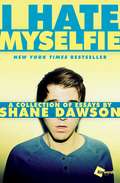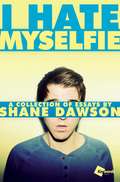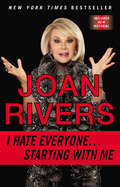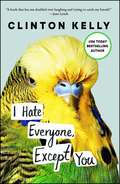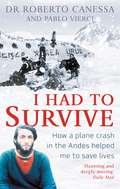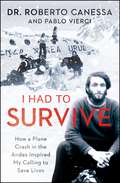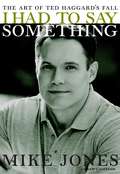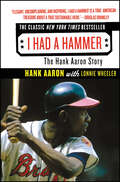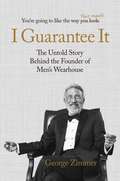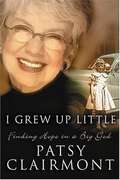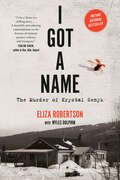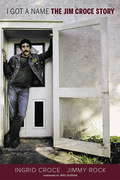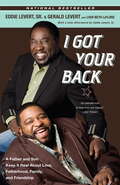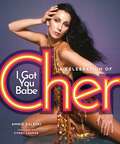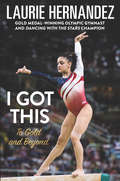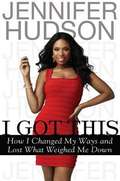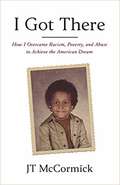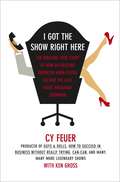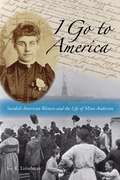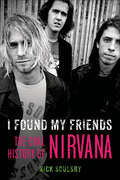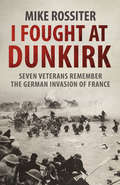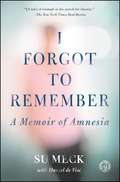- Table View
- List View
I Hate Myselfie: A Collection of Essays by Shane Dawson
by Shane DawsonThe book that more than 12 million YouTube subscribers have been waiting for! Shane Dawson's memoir features twenty original essays--uncensored yet surprisingly sweet.From his first vlog back in 2008 to his full-length film directorial debut Not Cool, Shane Dawson has been an open book when it comes to documenting his life. But behind the music video spoofs, TMI love life details, and outrageous commentary on everything the celebrity and Internet world has the nerve to dish out is a guy who grew up in a financially challenged but loving home in Long Beach, California, and who suffered all the teasing and social limitations that arise when you're a morbidly obese kid with a pretty face, your mom is your best friend, and you can't get a date to save your life. In I Hate Myselfie, Shane steps away from his larger-than-life Internet persona and takes us deep into the experiences of an eccentric and introverted kid, who by observing the strange world around him developed a talent that would inspire millions of fans. Intelligent, hilarious, heartbreaking, and raw, I Hate Myselfie is a collection of eighteen personal essays about how messy life can get when you're growing up and how rewarding it can feel when the clean-up is (pretty much) done.
I Hate Myselfie
by Shane DawsonThe book that more than 12 million YouTube subscribers have been waiting for! Shane Dawson's memoir features twenty original essays--uncensored yet surprisingly sweet. Shane Dawson has always been an open book. From his first YouTube vlog back in 2008, to his feature film debut "Not Cool," to a cover story in Variety magazine, Shane has documented his life pre-tty thoroughly. We've seen awkward and adorable Q&As with his mom, weight loss center drama, love life details, and the all-important haircut reveal. We've seen his hilarious spoofs of Miley Cyrus, Paris Hilton, and Sarah Palin. His music videos are awesome. But in I Hate Myselfie!, fans will finally get a chance to see the real Shane through personal stories that are at once humorous and heartwarming, self-deprecating and totally inspiring. Highlighting key moments of his childhood and adolescence, through his phenomenal success on YouTube, and continuing on to his more recent experiences as an actor and director, Shane's memoir will feature the silliness and satire his fans already enjoy, but it will be even more in depth, more real, and more portable (it's a book).
I Hate Everyone...Starting with Me
by Joan RiversNOW WITH NEW MATERIAL FOR THE PAPERBACK EDITION "How do I love thee? Let me count the ways." --Elizabeth Barrett Browning, 1850 "How do I hate thee? How much time do you have?" --Joan Rivers, today, about two-ish Joan Rivers, comedienne, actress, jewelry monger, and an award-winning international star (she can sneer in eight different languages) lives by the golden rule: Do unto others before they do unto you--and for God's sakes, do it funny! Her career in comedy may have begun with self-loathing, but, after looking at the decrepitude around her, she figured, "Why stop here when there are so many other things to hate?" With all of her experiences, Joan has looked down at, turned away from, and thrown up over a lot of hateful things, deplorable places, and despicable people. Thank God she took notes. Here--uncensored and uninhibited--Joan says exactly what's on her mind...And HER mind is a terrible thing to waste. She proudly kicks the crap out of ugly children, dating rituals, funerals, and lousy restaurants. She nails First Ladies, closet cases, and hypocrites to the wall. She shows no mercy towards doctors and feminists, and even goes after Anne Frank and Stephen Hawking. Joan lets everyone--including herself--have it in this one hundred percent honest and unabashedly hilarious love letter to the hater in all of us. This is absolute Joan Rivers. You gotta love her. Even if she hates you. Includes new material!
I Hate Everyone, Except You
by Clinton KellyBestselling author and television host Clinton Kelly pens a hilariously candid, deliciously snarky collection of essays about his journey from awkward kid to slightly-less-awkward adult.Clinton Kelly is probably best known for teaching women how to make their butts look smaller. But in I Hate Everyone, Except You, he reveals some heretofore-unknown secrets about himself, like that he’s a finicky connoisseur of 1980s pornography, a disillusioned critic of New Jersey’s premier water parks, and perhaps the world’s least enthused high-school commencement speaker. Whether he’s throwing his baby sister in the air to jumpstart her cheerleading career or heroically rescuing his best friend from death by mud bath, Clinton leaps life’s social hurdles with aplomb. With his signature wit, he shares his unique ability to navigate the stickiest of situations, like deciding whether it’s acceptable to eat chicken wings with a fork on live television (spoiler: it’s not). Clinton delves into all these topics—and many more—in this thoroughly unabashedly frank and uproarious collection.
I Had to Survive: How a plane crash in the Andes helped me to save lives
by Pablo Vierci Dr Dr. Roberto CanessaOn 12 October 1972, a Uruguayan Air Force plane carrying members of the 'Old Christians' rugby team (and many of their friends and family members) crashed into the Andes mountains. I Had to Survive offers a gripping and heartrending recollection of the harrowing brink-of-death experience that propelled survivor Roberto Canessa to become one of the world's leading paediatric cardiologists.Canessa, a second-year medical student at the time, tended to his wounded teammates amidst the devastating carnage of the wreck and played a key role in safeguarding his fellow survivors, eventually trekking with a companion across the hostile mountain range for help.This fine line between life and death became the catalyst for the rest of his life.This uplifting tale of hope and determination, solidarity and ingenuity gives vivid insight into a world famous story. Canessa also draws a unique and fascinating parallel between his work as a doctor performing arduous heart surgeries on infants and unborn babies and the difficult life-changing decisions he was forced to make in the Andes. With grace and humanity, Canessa prompts us to ask ourselves: what do you do when all the odds are stacked against you?
I Had to Survive: How a Plane Crash in the Andes Inspired My Calling to Save Lives
by Pablo Vierci Dr. Roberto CanessaDr. Roberto Canessa recounts his side of the famous 1972 plane crash of Uruguayan Air Force Flight 571 in the Andean Mountains and how, decades later, the harrowing journey to survive propelled him to become one of the world&’s leading pediatric cardiologists, seeing in his patients the same fierce will to live he witnessed in the Andes.As he tended to his wounded Old Christians teammates amidst the devastating carnage, rugby player Roberto Canessa, a second-year medical student at the time, realized that no one on earth was luckier: he was alive—and for that, he should be eternally grateful. As the starving group struggled beyond the limits of what seemed possible, Canessa played a key role in safeguarding his fellow survivors, eventually trekking with a companion across the hostile mountain range for help. No one could have imagined that there were survivors from the accident in such extreme conditions. Canessa's extraordinary experience on the fine line between life and death became the catalyst for the rest of his life. This uplifting tale of hope and determination, solidarity and ingenuity, gives vivid insight into the world-famous story that inspired the movie Alive! Canessa also draws a unique and fascinating parallel between his work as a doctor diagnosing very complex congenital cardiopathies in unborn and newborn infants and the difficult life-changing decisions he was forced to make in the Andes. With grace and humanity, Canessa prompts us to ask ourselves: what do you do when all the odds are stacked against you?
I Had to Say Something: The Art of Ted Haggard's Fall
by Mike Jones Sam GallegosThis is the story of the sexual relationship between Michael Forest Jones, a Denver man who worked as an escort, and the Reverend Ted Haggard, founder and pastor of the New Life Church of Colorado Springs.As a rule, Mike never delved into the personal lives of his clients. He entertained celebrities, clergyman, politicians, pro-football players, and just regular guys. In 2003, a man named "Art" called Mike to set up an appointment. For almost three years, Art came to see him at least once a month. It was simply a business relationship for Mike, yet he sensed that for Art, it was more. Like many clients who were closeted, Art revealed his vulnerabilities as he struggled to deny his true desire for sexual contact and affection with a man.One day, while working out at his gym, Mike recognized "Art" preaching hate on a religious cable channel. He soon discovered that Art was actually the Reverend Ted Haggard, who, as President of the National Association of Evangelicals, influenced the daily lives of millions of believers, condemning homosexuality and advocating virulently against gay rights and same-sex unions. On November 1, 2006, Mike made public his relationship with Ted Haggard. Within days, Haggard resigned from all his positions of power, admitting to a "sexual immorality" that shook the evangelical world, right before Election Day 2006. Once Haggard was outed, Mike's clients stopped calling. He had effectively put himself out of business and put himself at risk of being trivialized and dismissed, as sex workers often are. It was Mike's courage and strength of conscience that ultimately led him to come forward about the hypocrisy of Haggard's life. Here is the disarming story of how one man's deceit inspired another man to become a spokesperson for telling the truth and for not being ashamed of who you are.
I Had a Hammer: The Hank Aaron Story
by Lonnie Wheeler Hank AaronI Had a Hammer: The Hank Aaron Story is an intimate memoir by a baseball legend—and a fascinating social history of twentieth-century America.The Classic New York Times BestsellerThe man who shattered Babe Ruth's lifetime home run record, Henry "Hammering Hank" Aaron left his indelible mark on professional baseball and the world. But the world also left its mark on him. With courage and candor, Aaron’s revelatory life story recalls his struggles and triumphs in an atmosphere of virulent racism. He relives the breathtaking moment when, in the heat of hatred and controversy, he hit his 715th home run to break Ruth's cherished record—an accomplishment for which Aaron received more than 900,000 letters, many of them vicious and racially charged. And his story continues through the remainder of his milestone-setting, barrier-smashing career as a player and, later, Atlanta Braves executive—offering an eye-opening and unforgettable portrait of an incomparable athlete, his sport, his epoch, and his world.“Elegant, uncomplaining, and inspiring, I Had a Hammer is a true American treasure about a true sustainable hero.” —New York Times–bestselling author Douglas Brinkley“Beautifully written. This book covers so many bases, it is virtually impossible to consider it just another sports biography.” —New York Times Book Review“[Hank Aaron’s] book is written with the same authority with which he wielded his bat.” —San Francisco Chronicle
I Guarantee It: The Untold Story behind the Founder of Men's Wearhouse
by George ZimmerAmerica knew George Zimmer for one of the most famous slogans in television advertising history: &“I guarantee it.&” Zimmer rode his promise to lead the Men&’s Wearhouse to unimagined success as a retail giant. Now, years removed from his stunning dismissal as leader of the company he founded, I Guarantee It recounts the journey of Zimmer&’s rise, the fall of the Men&’s Wearhouse, and his personal renewal. For forty-one years, George Zimmer forged a relationship with American men who wanted to like the way they looked without getting too fussy about it. He made them a promise that came straight from the shoulder: &“I guarantee it,&” he said, and it was ironclad. By the millions, customers walked into The Men&’s Wearhouse stores in all fifty states and Canada, where they received &“quality, service, and a good price,&” where they bought suits, ties, sports coats, and slacks by the tens of billions of dollars. Then a backstabbing — the handpicked board of directors fired Zimmer from the company he had created and developed into the most successful men&’s specialty store in world history. Eight years later, Zimmer is back to tell his story: a man raised by a prosperous and loving family, a fun-loving son of the sixties, a merchant, an entrepreneur, a pitchman for the ages. Zimmer&’s ouster devastated but did not destroy him. His is a story of hard work and resilience, about a life in business that succeeded beyond belief and followed the Golden Rule. It&’s a story that will teach and inspire. He guarantees it.
I Grew Up Little: Finding Hope in a Big God
by Patsy ClairmontA REBELLIOUS TEENAGER. HIGH SCHOOL DROPOUT. BRIDE AT SEVENTEEN AND A MOTHER AT TWENTY. Soon she became a terrified victim of agoraphobia--a prisoner shackled by fear in her own home. Lost in the shadowy darkness of depression, there was little hope for this woman to reemerge into the light, much less excel at life. But reemerge she did. Excel she has. And how! Standing five feet even, popular speaker, author, and humorist Patsy Clairmont laughingly says, "I grew up little." But this petite body houses a gigantic, courageous heart. And this amazing little woman evokes gales of laughter and joy from hundreds of thousands of women every year as she literally dominates the massive stages at Women of Faith® conferences. How did she do it? How did she conquer her suffocating fears and find her way back to the freedom of winged hope? This delightfully written autobiography reveals Patsy's greatest struggles, her biggest failures, and the secret to her ultimate triumphs. An incredible story of overwhelming fear meeting overcoming faith, this is the autobiography of a little lady, who found hope in a big God.
I Got a Name: The Murder of Krystal Senyk
by Eliza Robertson Myles DolphinA vivid and meticulous true-crime story that exposes the deep fractures in a system that repeatedly fails to protect women, while tracking the once-cold trail of a murderer still at large.Krystal Senyk was the kind of friend everybody wants: a reliable confidant, a handywoman of all trades, and an infectious creative with an adventurous spirit. Most importantly, she was tough as nails. So when her best friend needed support to leave her abusive husband, Ronald Bax, Krystal leapt into action.But soon Krystal became the new outlet for Bax&’s rage. He terrorized and intimidated her for months on end, and finally issued a chilling warning to her and his ex-wife: the hunt is on. Krystal was scared but she was smart: she reached out to the RCMP for a police escort home. The officer brushed her off.Bax&’s threat had been all too real. At 29 years old, the woman who seemed invincible—who was a beloved sister, daughter, and friend—was shot and killed at her home in the Yukon. Ronald Bax disappeared without a trace.Three decades later, Eliza Robertson has re-opened the case. In compelling, vibrant prose, she works tirelessly to piece together Krystal&’s story, retracing the dire failings of Canadian law enforcement and Bax&’s last steps. I Got a Name uses one woman&’s tragic story to boldly interrogate themes of gender-based violence and the pervasive issues that plague our society. In this riveting true-crime story about victimhood, power, and control, Robertson examines the broken system in place, and asks: if it isn&’t looking out for the vulnerable, the threatened, the hunted—who among us is it protecting?
I Got a Name: The Jim Croce Story
by Ingrid Croce Jimmy RockJim Croce, singer-songwriter of the #1 hitsBad Bad Leroy BrownandTime in a Bottle, was at the height of his career when his life was cut short in a plane crash while on tour. Just 30 years old on September 20, 1973, Jim was revered by an adoring audience for his gentle melodies and everyman demeanor. Now, for the first time, this memoir reveals the man behind the denim jackets and signature mustache, a hard-working, wry charmer who was also beset with exhaustion at the sheer magnitude of his own success. I Got a Name, told with full access to everyone who knew and loved Jim Croce, is at once a revealing portrait of a great artist and a moving love story.
I Got Your Back: A Father and Son Keep It Real About Love, Fatherhood, Family, and Friendship
by Eddie Levert Gerlad Levert Lyah Beth LefloreThe final collaboration from Eddie and Gerald Levert is an intimate glimpse into their lives, their passions, and their musical legacy. But most important, this book gets inside the special and rare father-son bond that these two R & B legends shared.
I Got You Babe: A Celebration of Cher
by Annie ZaleskiCovering her life and sixty-year career from Sonny & Cher to show-stopping solo performer, award-winning actress, fashion icon, and beyond, this is a glorious retrospective of one of the world&’s most enduring entertainers, Cher. Featuring a foreword by Cyndi Lauper! Commemorating six decades since her first #1 hit in 1965, I Got You Babe captures Cher&’s one-of-a-kind life. Written by award-winning writer and editor Annie Zaleski, this celebration of the fearless, down-to-earth &“Goddess of Pop&” explores key moments in her life and career in words and photos. Among the topics covered: Her 50-year friendship with fellow diva Tina Turner, which began in 1975 when they performed &“Shame, Shame, Shame&” together. Her story of creating a &“revenge dress&” with designer Bob Mackie for the 1986 Oscars after being snubbed for a nomination for her performance in Mask. The night in 1989 she made the Navy wish it could &“Turn Back Time&” by arriving at the USS Missouri to film her video not wearing the coveralls they expected but a barely-there fishnet bodysuit. Cher&’s unfiltered social media presence. From classic posts like &“BREAKING NEWS: IM BEING BURIED IN MY FISHNETS&” to weighing in on issues she believes in. When Cher learned about Kaavan, dubbed &“the world&’s loneliest elephant.&” The creature was kept in chains in a zoo in Pakistan and forced to perform for decades. After fans brought the problem to her attention, Cher eventually helped get him moved in 2021, and her efforts were captured in a Smithsonian documentary. Amid these moments are photo after photo of some of the most eye-popping outfits ever worn in life and on stage. As an avid clothes horse who wasn&’t afraid to wear a see-through dress to the Met Gala in 1974, Cher&’s many looks will be given their due in this engaging, career-spanning retrospective.
I Got This: To Gold and Beyond
by Laurie Hernandez<P>Gold medal-winning Olympic gymnast and Dancing with the Stars champion Laurie Hernandez shares her story in her own words in this debut book for fans of all ages—with never-before-seen photos! <P>At sixteen years old, Laurie Hernandez has already made many of her dreams come true—and yet it’s only the beginning for this highly accomplished athlete. A Latina Jersey girl, Laurie saw her life take a dramatic turn last summer when she was chosen to be a part of the 2016 US Olympic gymnastics team. After winning gold in Rio as part of the Final Five, Laurie also earned an individual silver medal for her performance on the balance beam. Nicknamed “the Human Emoji” for her wide-eyed and animated expressions, Laurie continued to dance her way into everyone’s hearts while competing on the hit reality TV show Dancing with the Stars, where she was the youngest-ever winner of the Mirrorball Trophy. <P>Poignant and funny, Laurie’s story is about growing up with the dream of becoming an Olympian and what it took to win gold. She talks about her loving family, her rigorous training, her intense sacrifices, and her amazing triumphs. Be prepared to fall in love with and be mesmerized by America’s newest sweetheart all over again. <P><b>A New York Times Bestseller</b>
I Got This: How I Changed My Ways and Lost What Weighed Me Down
by Jennifer HudsonAn honest and inspirational story of dreaming big, winning big, and losing big, by one of today’s most-beautiful voices and brightest Hollywood stars. Exciting, inspirational, and honest, I Got This is Jennifer’s journey from a girl growing up on Chicago’s South Side to performing on the American Idol stage, where she heard not one but numerous remarks about her look not being right for stardom. Tired of always trying to look the part, and raising a son for whom Jennifer wanted to set a good example, she decided to get healthy. She would lose the weight, once and for all—not for a role, not for a record label, but for herself. Teaming up with Weight Watchers and using their PointsPlus® program, Jennifer learned how to think about food differently, and in the process, changed her life for the better. In I Got This, she’ll show you how she embraced Weight Watchers as a realistic, healthy way of life and helps anyone who has ever suffered from a weight problem to do the same. .
I Got There: How I Overcame Racism Poverty and Abuse to Achieve the American Dream
by Tucker Max Jt McCormick<P><P>"I'm not a drug dealer. I'm not a rapper. I'm not an athlete. But I am very successful." <P><P> That's not how you're supposed to open a speech if you're a successful businessman. Especially if you're a successful minority businessman in America. <P><P> But I'm no ordinary businessman, this was no ordinary speech, and I've had no ordinary life. <P><P> JT McCormick shouldn't have succeeded. <P><P> He was born the mixed-race son of a negligent, drug-dealing pimp father and a struggling, single mother. He was raised in the slums of Dayton, Ohio, suffered incredible abuse and racism, and had multiple stints in the juvenile justice system. He barely graduated high school and has no college degree. <P><P> But succeed he did. <P><P> Starting by scrubbing toilets, JT hustled and worked his way into better opportunities, eventually finding incredible success in the mortgage industry. He was on top of the world. <P><P> And then it all fell apart. He lost his job, and his money. <P><P> But instead of stopping him, this setback became the springboard for him to reach even bigger heights--eventually growing and becoming President of a multimillion-dollar software company, and then CEO of a multimillion-dollar book-publishing start-up. <P><P> Gripping, heartbreaking, enlightening, and ultimately uplifting, I Got There proves that no obstacle is too difficult to conquer--and that the game can be won by anyone, from anywhere.
I Got The Show Right Here
by Ken Gross Cy FeuerGuys & Dolls...The Boyfriend...How to Succeed in Business Without Really Trying...Can-Can... These are just a few of the many Broadway shows produced by the legendary Cy Feuer, who, in partnership with the late Ernest H. Martin, brought to life many of America's most enduring musicals. Cy Feuer was at the center of these creations, as well as the films based on two of Broadway's most exceptional musicals, Cabaret and A Chorus Line. He was the man in charge, the one responsible for putting everything together, and -- almost more important -- for holding it together. Now, at age ninety-two, as Cy Feuer looks back on the remarkable career he had on Broadway and in Hollywood, the stories he has to tell of the people he worked with are fabulously rich and entertaining. There's Bob Fosse, a perfectionist with whom Feuer did battle over the filming of the movie Cabaret. There's Frank Loesser, the brilliant and explosive composer of Guys & Dolls, Where's Charley?, and How to Succeed... There's Liza Minnelli, star of both the movie Cabaret and the Broadway musical The Act, whose offstage activities threatened to disrupt the show. There's the contentious George S. Kaufman, the librettist and director whose ego was almost as great as his talent. Add to the list such glamorous figures as Cole Porter, Julie Andrews, Abe Burrows, Gwen Verdon, John Steinbeck, Martin Scorsese, and George Balanchine, and you have a sense of the unbeatable cast of characters who populate this fabulous story of a young trumpet player from Brooklyn who became musical director for the Republic Pictures film studio, then feverishly tackled Broadway, back when "putting on a show" did not require the support of major corporations, and when dreams of overnight success really did have a chance of coming true. Funny, witty, and immensely entertaining, I Got the Show Right Here is a treat for anyone who loves show business, a story wonderfully told by one of Broadway's greatest and most talented producers.
I Got Mine: Confessions of a Midlist Writer
by John NicholsI Got Mine: Confessions of a Midlist Writer is the memoir of Nichols&’ extraordinary life, as seen through the lens of his writing. Everything that went into making him a writer and eventually found an outlet in his work—his education, family, wives, children, friends, enemies, politics, and place—is told from the point of view of his daily practice of writing.Beginning with his first novel, The Sterile Cuckoo, published in 1965 when he was just twenty-four, Nichols shares his highs and lows: his ambivalent relationship with money; his growing disenchantment with the hypocrisy of capitalism; and his love-hate relationship with Hollywood—including the years-long struggle of working with director Robert Redford on the film version of The Milagro Beanfield War, which was filmed around Truchas and featured many of Nichols&’ northern New Mexico neighbors.Throughout I Got Mine Nichols spins a shining thread connecting his lifelong engagement with progressive political causes, his passionate interest in and identification with ordinary people, and his deep connection to the land.
I Got It From Here: A Memoir of Awakening to the Power Within
by Francesca MiracolaGrowing up in an Italian American family in Queens, New York, in the ’70s, Francesca Miracola was trained from an early age to keep up appearances at all costs—but behind closed doors, her parents’ toxic marriage served as a blueprint for dysfunction. So when she met Jason Axcel at a bar as a twentysomething, she ignored all the red flags—and there were plenty of them—and dove right in, normalizing his emotional and physical abuse just like she’d learned to do. She even married and had two children with him. But something in her clicked one night when Jason strolled out the door after a vicious fight that left her degraded on the floor, and she decided she was done. Except Jason wouldn’t let her go. Even after they finally divorced and Francesca fell in love with someone else, her ex-husband was keen enough to recognize that she was the same broken girl he’d met a decade earlier, and he exploited that fact at every turn. He called the cops to her home with bogus claims; he bombarded her with provoking emails and texts; he stalked her every move; and, worst of all, he used their little boys as pawns in his campaign. Then he went for the jugular and sued her for custody. But Francesca was stronger than he’d given her credit for. Raw and illuminating, I Got It from Here is one woman’s story of saving herself and her children from the grips of a sociopath posing as a family man—and from the inherited trauma passed down by her own family of birth—while learning to trust in the inner voice that’s been trying to guide her all along.
I Go to America: Swedish American Women and the Life of Mina Anderson
by Joy K. LintelmanNear the end of her life, Mina Anderson penned a lively memoir that helped Swedish novelist Vilhelm Moberg create "Kristina", the central female character of his beloved emigrant novels, a woman who constantly yearns for her homeland. But Mina's story was quite different. Showcasing her previously untranslated memoir, "I Go To America" traces Mina's trip across the Atlantic to Wisconsin and then the Twin Cities, where she worked as a domestic servant, and her move to rural Mille Lacs County, where she and her husband worked a farm, raised seven children, and contributed to rural Swedish community life. Mina herself writes about how grateful she was for the opportunity to be in America, where the pay was better, class differences were unconfining, and children -- girls included -- had the chance for a good education. In her own words, "I have never regretted that I left Sweden. I have had it better here". Joy Lintelman greatly expands upon Mina's memoir, detailing the social, cultural, and economic realities experienced by countless Swedish women of her station. Lintelman offers readers both an intimate portrait of Mina Anderson and a window into the lives of the nearly 250,000 young, single Swedish women who immigrated to America from 1881 to 1920 and whose courage, hard work, and pragmatism embody the American dream.
I Freed Myself
by David WilliamsFor a century and a half, Abraham Lincoln's signing of the Emancipation Proclamation has been the dominant narrative of African American freedom in the Civil War era. However, David Williams suggests that this portrayal marginalizes the role that African American slaves played in freeing themselves. At the Civil War's outset, Lincoln made clear his intent was to save the Union rather than free slaves - despite his personal distaste for slavery, he claimed no authority to interfere with the institution. By the second year of the war, though, when the Union army was in desperate need of black support, former slaves who escaped to Union lines struck a bargain: they would fight for the Union only if they were granted their freedom. Williams importantly demonstrates that freedom was not simply the absence of slavery but rather a dynamic process enacted by self-emancipated African American refugees, which compelled Lincoln to modify his war aims and place black freedom at the center of his wartime policies.
I Found My Friends: The Oral History of Nirvana
by Nick SoulsbyI Found My Friends recreates the short and tempestuous times of Nirvana through the musicians and producers who played and interacted with the band. The guides for this trip didn't just watch the life of this legendary band—they lived it. Soulsby interviewed over 150 musicians from bands that played and toured with Nirvana, including well-known alternative and grunge bands like Dinosaur Jr., The Dead Kennedys, and Butthole Surfers, as well as scores of smaller, but no less fascinating bands.In this groundbreaking look at a legendary band, readers will see a more personal history of Nirvana than ever before, including Nirvana's consideration of nearly a dozen previously unmentioned candidates for drummer before settling on David Grohl, a recounting of Nirvana's famously disastrous South American shows from never-before-heard sources on Brazilian and Argentine sides, and the man who hosted the first ever Nirvana gig's recollections of jamming with the band at that inaugural event.I Found My Friends relives Nirvana's meteoric rise from the days before the legend to through their increasingly damaged superstardom. More than twenty years after Kurt Cobain's tragic death, Nick Soulsby removes the posthumous halo from the brow of Kurt Cobain and travels back through time to observe one of rock and roll‘s most critical bands as no one has ever seen them before.
I Fought at Dunkirk: Seven Veterans Remember Their Fight For Salvation
by Mike RossiterSURVIVOR STORIES FROM DUNKIRK, NOW THE SUBJECT OF A MAJOR FILM FROM CHRISTOPHER NOLANWhen Britain declared war against Germany in September 1939, thousands of young men sailed across the English Channel to fight for their country. Among them were the seven soldiers who share their stories in this book. Some joined up out of patriotism, others for adventure or the prospect of a secure wage. They were fit, trained and proud to wear the armband of the British Expeditionary Forces. For many, the first months were strangely peaceful, but when the Germans invaded in May 1940 they advanced with shocking speed. The German armoured columns sliced through neutral Holland and Belgium. The French Army collapsed and within a week the soldiers of the BEF were forced to retreat. Fighting tough and bloody rearguard actions, they endured relentless shelling and fearsome dive-bomb attacks. Constantly on the move, and facing a German onslaught on three fronts, they were soon exhausted, hungry and low on ammunition. They headed finally to their one chance of salvation: the beaches of Dunkirk. Mike Rossiter tells the stories of seven veterans who went through a hellish baptism of fire in the first battles on the front line, and fought in the last-ditch defence of Dunkirk. They saw their comrades bombed and drowned off the beaches. Their accounts give us a fascinating and privileged insight into the reality of the war and what it was really like to face the German Blitzkrieg in 1940. They take us from the confident, idyllic days of the phoney war in the French countryside to the sudden shock of battle, from the fear and confusion of retreat to the wait for an uncertain rescue. These are the compelling stories of seven men who are proud to say I Fought at Dunkirk.
I Forgot to Remember: A Memoir of Amnesia
by Su Meck Daniel de ViséThe courageous memoir of a woman who was robbed of all her memories by a traumatic brain injury—and her more than twenty-five-year struggle to reclaim her life: “[A tale] of triumph in the search for identity” (The New York Times Book Review).In 1988, Su Meck was twenty-two and married with two children when a ceiling fan fell and struck her on the head, erasing all her memories of her life. Although her body healed rapidly, her memories never returned. After just three weeks in the hospital, her physicians released Su and she returned home to take care of her two toddlers. What would you do if you lost your past? Adrift in a world about which she understood almost nothing, Su became an adept mimic, gradually creating routines and rituals that sheltered her and her family from the near-daily threat of disaster—or so she thought. Though Su would eventually relearn to tie her shoes, cook a meal, read, and write, nearly twenty years would pass before a series of personally devastating events shattered the “normal” life she had worked so hard to build, and she realized that she would have to grow up all over again. In her own indelible voice, Su offers a unique view from the inside of a terrible injury as she “recounts her grueling climb back to normalcy…in this heart-wrenching true story” (O, The Oprah Magazine). Piercing, heartbreaking, but finally uplifting, I Forgot to Remember is the story of a woman determined to live life on her own terms.
